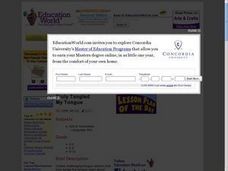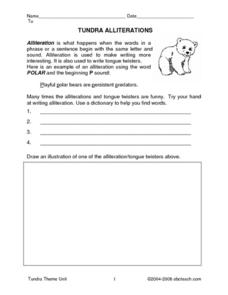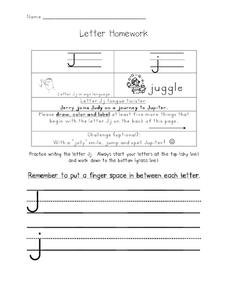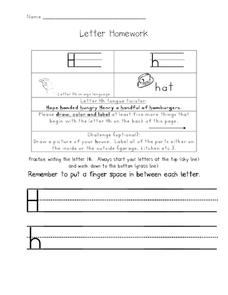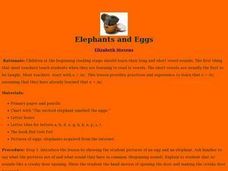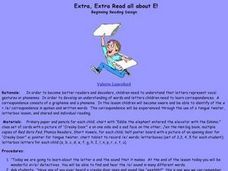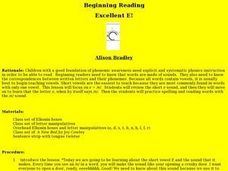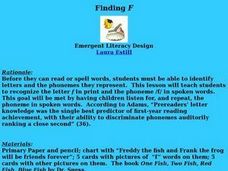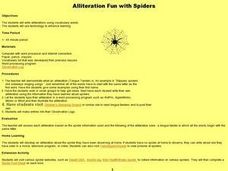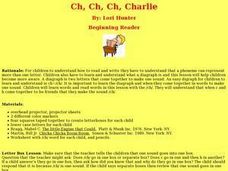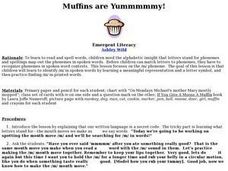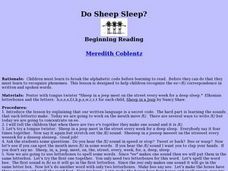Poetry4kids
How to Write a Tongue Twister
Betty Botter and Theophilus Thistle provide models for willy writers to wrestle words into tricky tongue twisters.
Curated OER
Tongue Twisters
Young readers practice their letter sounds by engaging with this language arts PowerPoint. Six letters are used: p, l, s, w, c, and d. Pupils learn tongue twisters for each letter such as: "Wiggly worm wiggles in the water." Very nice!
Curated OER
Tom's Tempting Tongue Twister Truly Tangled My Tongue
Students explore what makes a good tongue twister. They identify parts of speech in different tongue twisters and create a tongue twister that truly tangles the tongue.
Curated OER
Test Your Speaking Skills-- Tongue Twisters
In this language and speech worksheet, students learn to articulate similar sounds by pronouncing tongue twisters. There are 32 to try and are organized by the beginning letter.
Curated OER
ALLITERATIONS (TONGUE TWISTERS) TO READ ALOUD
In this alliterations activity sheet, students are given 11 tongue twisters (alliterations) to read aloud. These are divided into "easy to reads" and "more advanced". This is a good phonemic awareness activity for native English...
Curated OER
Arctic Alliterations
In this poetry worksheet, students read a description of an alliteration with an example. Students practice writing alliterations with the help of a dictionary and illustrate one of their tongue twisters.
Curated OER
Rain Rain Go Away
Complete a variety of activities related to the long /a/ sound with a focus on words containing the ai and ay correspondence with your readers. As a class, they recite a tongue twister, then spell different words containing ay and ai...
Curated OER
Tongue Twisters
In this oral language worksheet set, students practice saying 16 tongue twisters. They recite the short poems that highlight the sound of different letters of the alphabet. There are no questions related to this worksheet.
Curated OER
ABC Book of Tongue Twisters
Students construct sentences using alliteration. In this phonemic awareness lesson, students listen to a read aloud such as Some Smug Slug and identify alliteration. Students write their own sentences using alliteration.
Curated OER
Letter Homework: Gg
In this recognizing and using the letter Gg worksheet, students sign the letter in sign language, copy a letter Gg tongue twister, draw, color, and label five or more items that begin with the letter Gg, and complete an optional...
Curated OER
Letter Homework: Jj
In this recognizing and using the letter "J" worksheet, students sign the letter in sign language, copy the capital letter and lower case letter, copy a "J" tongue twister, and draw, color, and label five or more things that begin with...
Curated OER
Letter Homework: Hh
In this recognizing and using the letter Hh worksheet, students sign Hh in sign language, practice printing the upper case and lower case letters, copy a letter Hh tongue twister, draw, color, and label five or more things that being...
Curated OER
Elephant Eggs
Study the short and long sounds of the letter e. Learners will practice words and tongue twisters using both the short and long vowel /e/. They use letter boxes and letter tiles to spell words containing the target sound. To close the...
Curated OER
Sound of the Runners, H = /h/
A variety of activities related to the /h/ phoneme are included here. Recite an H tongue twister then trace and write the letter H. The group listens to pairs of words and identifies which word contains the /h/ sound.
Curated OER
Extra, Extra Read all about E!
Learners examine the letter 'e'. Through instruction and modeling they explore the sound the letter makes, how the letter is written, etc. They recite tongue twisters and use letterboxes to write 'e' words. They pick out short /e/ words...
Curated OER
Ohhhh Me, Ohhhhh My!
Students practice identifying phonemes and recognizing letters in written words to become fluent readers. They study the phoneme /O/ in the tongue twister, "Oh No, my Nose needs an operation in October." Each student also interacts with...
Curated OER
Excellent E!
Students explore the short /e/ sound. They practice making the sound and recite an 'e' tongue twister. They practice writing the letter e and use Elkonin letter boxes to spell e words. In groups, they read stories and identify short /e/...
Curated OER
Finding F
Students complete a variety of activities as they explore the letter 'f'. Through instruction and modeling they examine the sound the letter makes, how the letter is written, etc. They recite tongue twisters and listen to 'One Fish, Two...
Curated OER
Alliteration Fun with Spiders
Students practice using vocabulary words to write alliterations. In this language arts lesson plan, students collaborate with classmates to create ideas for fun alliterations as they create their own using a children's word...
Curated OER
Suppressing Short O
Students complete a variety of activities as they explore/review the letter 'o' and the short /o/ sound. They recite short /o/ tongue twisters, practice writing the letter 'o', and listen to stories, identifying words with the short /o/...
Curated OER
Ch, Ch, Ch, Charlie
Students explore the /ch/ phoneme and how it just a combination of the /c/ and /h/ sounds. They recite /ch/ tongue twisters and write 'ch' words using letterboxes. They identify /ch/ words while reading the story, 'Chica Chica Boom Boom.'
Curated OER
Muffins are Yummmmmy!
Students explore phonemes. They discuss the phoneme /m/. Students learn a tongue twister to help them identify the phoneme /m/. They read "If You Give A Moose a Muffin." Students search for /m/ words while reading the story. They...
Curated OER
Emergent Literacy Design: Going to the Doctor
Students complete a variety of activities as they explore/review the letter 'o' as it makes the short /o/ sound. Like a doctor would, they look at each other's throats as they say "ahhh" and make the short /o/ sound. They say and make...
Curated OER
Do Sheep Sleep?
Students gain insight into the correspondence ee = /EE/ in both written and spoken words. They recite tongue twisters with the /EE/ sound and use letterboxes to spell 'ee' words. They read a book with a variety of /EE/ words.




